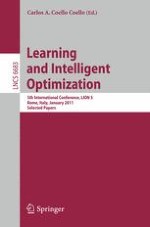This book constitutes the thoroughly refereed post-conference proceedings of the 5th International Conference on Learning and Intelligent Optimization, LION 5, held in Rome, Italy, in January 2011. The 32 revised regular and 3 revised short papers were carefully reviewed and selected from a total of 99 submissions. In addition to the contributions to the general track there are 11 full papers and 3 short papers presented at the following four special sessions; IMON: Intelligent Multiobjective OptimizatioN, LION-PP: Performance Prediction Self* EAs: Self-tuning, self-configuring and self-generating evolutionary algorithms LION-SWAP: Software and Applications.
